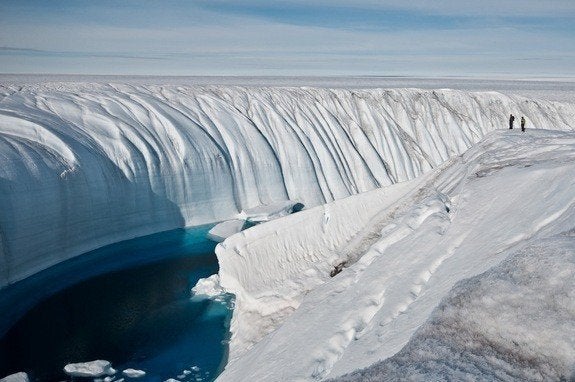
New study on climate sensitivity has some good news and some not so good news.
The Holy Grail for Climate Science
For many in the climate science business, the climate sensitivity is a sort of holy grail. Its technical definition is the equilibrium change in the global average temperature that results from a doubling in carbon dioxide (CO2). (More on climate sensitivity.)
More practically, we can think of the climate sensitivity as a metric for how much the climate will warm in the coming decades to century as greenhouse gases build up in the atmosphere.
And that's why pinning down the climate sensitivity is viewed by many as being of paramount importance -- it's a predictor of what lies ahead of us climate-wise, which in turn provides a guide on how fast and hard we need to dial down emissions and get ready for change. A high sensitivity means lots of climate disruption and soon, while a low one foreshadows a more modest rate of climate change.
There have been myriad estimates of the climate sensitivity by myriad scientific groups using a myriad of methods. (See here and here.)
Some estimates have involved climate model simulations; others have used records of past or contemporary climate variations to infer the sensitivity of the climate to perturbations; still others have taken a hybrid approach using both models and climate data. And then there are synthesis estimates like those presented in the Intergovernmental Panel on Climate Change (IPCC) reports that try to derive a central value from multiple studies.
The Uncertainty Game
Based on the last IPCC estimate, our climate's sensitivity most likely ranges between 2 degrees to 4.5 degrees Celsius (3.6 degrees to 8 degrees Fahrenheit) with a central value of 3 degrees Celsius (5.4 degrees Fahrenheit). Since the IPCC report, there have been a number of new studies: some concluding that the sensitivity lies at the high end of this range, some concluding that it lies at the low end, and still others that estimate a sensitivity near the central value.
The range provided by these studies has been useful in providing input to policy makers trying to develop strategies for mitigating and/or adapting to climate change, but leave a large range of uncertainty.
If we should be so lucky that the climate sensitivity lies at the low end of the range, it is likely that the warming in the coming decades will be relatively modest and we have some more time before the climate stuff hits the fan. If the climate sensitivity is on the high side, we're likely already way behind the curve on the climate change front.
Some argue that recent events confirm that the latter scenario is already playing out. I find that point of view cogent but will wait a bit longer before concluding that recent events are part of a long-term trend.
The upshot of all this? When it comes to projecting the future, we are pretty much flying blind. We know it's going to get warmer but remain pretty fuzzy on how much warmer and how fast.
New Study Helps with Flying Blind Scenario?
Now Julia Hargreaves of the Research Institute for Global Change in Yokohama, Japan, and colleagues report in the journal Geophysical Research Letters their results from a new study of the climate sensitivity. The unique aspect of this study is the use of an ensemble of seven climate models whose estimates of climate sensitivity were filtered based on their ability to accurately simulate the temperature change during the Last Glacial Maximum. (See sidebar below.)
Their results: they "estimate the... climate sensitivity to be about 2.5 C with a high probability of being under 4 C." Their lowest sensitivity estimate was 1.8 degrees Celsius.
Okay, so the good news.
Did you notice that these values are virtually the same as the consensus values cited above? This suggests that the policies we have been pursuing (such as they are) based on previous studies are largely on target.
My Bottom Line
While some may look upon constraining the climate sensitivity as the holy grail, I consider it an honorable quest but one that’s unlikely to remove much of the uncertainty that remains today -- much as is the case with this latest Hargreaves et al study.
Whatever we do, we are going to have to accept the fact that our decisions with regard to climate are going to have to be made in the face of considerable uncertainty. Waiting for more certainty is a decision to ignore the considerable risks implied by the high sensitivity scenarios. It is simply not a reasonable course -- in my humble opinion.
Sidebar: Last Glacial Maximum
The earth has gone through many cycles of warming and cooling -- and continues to do so. During cool periods the climate is discernibly colder and ice covers significant fractions of the Earth's surface. The most recent cold period, known as the last glacial, began about 116,000 years ago, peaked between 27,000 and 19,000 years ago, and has been mostly warming, with some small cold excursions, ever since. The peak when ice was at its greatest extent is known as the Last Glacial Maximum, a much studied period for climate because the contributing factors are well understood.
Crossposted with TheGreenGrok | Follow us on Facebook
Correction: 1/11/2013
Post corrected to change the sidebar title to "Last Glacial Maximum," not minimum.